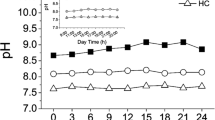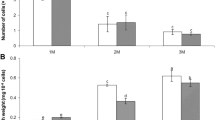Abstract
The aim of the present study was to examine the effects of salinity, high light intensity, and their interactions with acetate on the growth and changes taking place in the pigment, protein, and carbohydrate contents of Scenedesmus obliquus. Algal growth was inhibited by 300 mM NaCl, high light intensity, and their combination. Adding acetate to the culture medium considerably increased the fresh weight S. obliquus, even in cultures under stresses. The amounts of chlorophylls and total carotenoids decreased by stresses and acetate; however, addition of acetate to the cultures under stresses improved the reducing effect of stresses. Among carotenoids, the amount of astaxanthin, as a secondary carotenoid, increased, while the amount of β-carotene and lutein, as primary carotenoids, decreased under salinity and light stresses. The effects of acetate addition on two types of carotenoids under stress conditions were diverse. By adding acetate under stress condition, the amount of astaxanthin decreased; while the amount of β-carotene and lutein considerably increased. Stresses caused a decrease in protein and carbohydrate contents. Application of acetate alone stimulated biosynthesis of protein and carbohydrate in S. obliquus. Moreover, acetate improved the effects of stresses on reduction of protein and carbohydrate contents. The obtained results revealed that application of acetate was the most effective factor to enhance the biomass and astaxanthin production.





Similar content being viewed by others
References
Annan JN (2014) Growth and photosynthesis response of the green alga, Picochlorum oklahomensis to iron limitation and salinity stress. Int J Plant Physiol Biochem 6:7–18
Bartley G, Scolnik P (1995) Plant carotenoids: pigments for photoprotection, visual attraction, and human health. J Plant Cells 7:1027–1038
Belay A, Ota Y, Miyakawa K, Shimamatsu H (1993) Current knowledge on potential health benefits of Spirulina. J Appl Phycol 5:235–241
Borowitzka MA, Huisman JM, Osborn A (1991) Culture of the astaxanthin-producing green alga Haematococcus pluvialis. 1. Effects of nutrients on growth and cell type. J Appl Phycol 3:295–304
Boussiba S, Lu F, Vonshak A (1992) Enhancement and determination of astaxanthin accumulation in green alga Haematococcus pluvialis. Methods Enzymol 213:386–391
Boussiba S, Bing W, Yuan JP, Zarka A, Chen F (1999) Changes in pigments profile in the green alga Haematococcus pluvialis exposed to environmental stresses. Biotechnol Lett 21:601–604
Bradford MM (1976) A rapid and sensitive method for quantitation ofmicrogram quantities of protein utilizing the principle of protein-dye binding. J Anal Biochem 72:248–254
Burczyk J, Szkawran H, Zontek I, Czygan FCh (1981) Carotenoids in the outer cell-wall layer of Scenedesmus (Chlorophyceae). Planta 151:247–250
Chong AMY, Wong YS, Tam NFY (2000) Performance of different microalgal species in removing nickel and zinc from industrial waste water. Chemosphere 41:251–257
Dere S, Gunes T, Sivaci R (1998) Spectrophotometric determination of chlorophyll a, b and total carotenoid contents of some algal species using different solvents. Turkish J Bot 22:13–17
Dubois M, Gilles KA, Hamilton JK, Rebers PA, Smith F (1956) Phenol sulphuric acid method for total carbohydrate. Anal Chem 26:350
Harker M, Tsavalos AJ, Young AJ (1996) Factors responsible for astaxanthin formation in the chlorophyte Haematococcus pluvialis. Bioresource Technol 55:207–214
Ho SH, Chen WM, Chang JS (2010) Scenedesmus obliquus CNW-N as a potential candidate for CO2 mitigation and biodiesel production. Bioresource Technol 101:8725–8730
Kim MK, Park JW, Park CS, Kim SJ, Jeune KH, Chang MU, Acreman J (2007) Enhanced production of Scenedesmus spp. (green microalgae) using a new medium containing fermented swine wastewater. Bioresource Technol 98:2220–2228
Kirrolia A, Bishnoi NR, Singh N (2011) Salinity as a factor affecting the physiological and biochemical traits of Scenedesmus quadricauda. J Algal Biomass Util 2(4):28–34
Kobayashi M, Kakizono T, Nagai SH (1991) Astaxanthin production by a green alga, Haematococcus pluvialis, accompanied with morphological changes in acetate media. J Ferment Bioeng 71:335–339
Kobayashi M, Kakizono T, Nagai SH (1993) Enhanced carotenoid biosynthesis by oxidative stress in acetate-induced cyst cells of a green unicellular alga Haematococcus pluvialis. Appl Environ Microbiol 59(3):867–887
Li Y, Miao F, Geng Y, Lu D, Zhang C, Zeng M (2012) Accurate quantification of astaxanthin from Haematococcus crude extract spectrophotometrically. Chin J Oceanol Limnol 30(4):627–637
Pocock T, Krol M, Huner N (2005) The determination and quantification of photosynthetic pigments by reverse phase high-performance liquid chromatography, thin-layer chromatography, and spectrophotometry. Methods Mol Biol 274:137–148
Powls R, Britton G (1977) A series of mutant strains of Scenedesmus obliquus with abnormal carotenoid compositions. Arch Microbiol 113:275–280
Qin S, Liu G, Hu Z (2008) The accumulation and metabolism of astaxanthin in scenedesmus obliquus (chlorophyceae). Process Biochem 43:795–802
Rippka R, Deruelles J, Waterbury JB, Herdman M, Stanier RY (1979) Generic assignments, strain histories and properties of pure cultures of cyanobacteria. J Gen Microbiol 111:1–61
Sarada R, Tripathi U, Ravishankar GA (2002) Influence of stress on astaxanthin production in Haematococcus pluvialis grown under different culture conditions. Process Biochem 37:623–627
Yang XX, Zeng X, Ji Y, Liu Q (2003) Effects of sodium nitrate and sodium acetate concentrations on the growth and fatty acid composition of Brachiomonas submarina. J Ocean Univ Qingdao 2(1):75–78
Zarandi-Miandoab Z, Hejazi MA, Bagherieh-Najjar MB, Chaparzadeh N (2015) Light intensity effects on some molecular and biochemical characteristics of Dunaliella salina. Iran J Plant Physiol 5(2):1311–1321
Acknowledgements
The authors express their gratitude to the Research Council of the Shahid Bahonar University of Kerman and Iran National Science Foundation (INSF) for their financial support during the course of this project (p.n. 93002287).
Author information
Authors and Affiliations
Corresponding author
Rights and permissions
About this article
Cite this article
Mansouri, H., Hajizadeh, F. Interaction Effects of Salinity, High Light Intensity and Acetate on Growth and Pigment Production on Scenedesmus obliquus . Iran J Sci Technol Trans Sci 42, 1821–1826 (2018). https://doi.org/10.1007/s40995-017-0441-4
Received:
Accepted:
Published:
Issue Date:
DOI: https://doi.org/10.1007/s40995-017-0441-4




